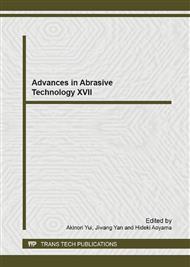p.154
p.160
p.166
p.175
p.181
p.187
p.193
p.199
p.205
Effect of Cutting Fluid on Diamond Tool Life under Micro V-Groove Turning of Cobalt-Free Tungsten Carbide
Abstract:
Micro-machining of hard dies and molds for optical parts or precision instruments is required to extend die and mold life. This paper investigates the effect of cutting fluid on diamond tool life under micro V-groove turning of cobalt-free tungsten carbide. Zinc dialkyldithiophosphate fluid (ZnDTP) displayed excellent diamond tool wear resistance in previous experiments. The performance of this cutting fluid is compared to newly developed vegetable oil based cutting fluid with dispersed MoS2 nanotubes. This paper investigates nanopolycrystalline diamond (NPD) tool life with a rake angle of 0° and-30° under continuous micro V-groove turning (i.e. face turning), of cobalt-free tungsten carbide using the developed cutting fluids. Superior diamond tool edge wear resistance is observed when using the dispersed MoS2 nanotubes in vegetable oil and using a NPD tool with a-30° rake angle.
Info:
Periodical:
Pages:
181-186
Citation:
Online since:
September 2014
Authors:
Price:
Сopyright:
© 2014 Trans Tech Publications Ltd. All Rights Reserved
Share:
Citation:


